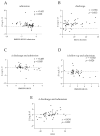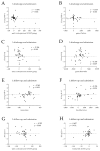Cytokine and Microbiome Changes in Adolescents with Anorexia Nervosa at Admission, Discharge, and One-Year Follow-Up
- PMID: 38892530
- PMCID: PMC11174589
- DOI: 10.3390/nu16111596
Cytokine and Microbiome Changes in Adolescents with Anorexia Nervosa at Admission, Discharge, and One-Year Follow-Up
Abstract
Anorexia nervosa (AN) is a severe eating disorder that predominantly affects females and typically manifests during adolescence. There is increasing evidence that serum cytokine levels are altered in individuals with AN. Previous research has largely focused on adult patients, assuming a low-grade pro-inflammatory state. The serum levels of the cytokine tumour necrosis factor-alpha (TNF-α), interleukin (IL)-1β, IL-6 and IL-15, which are pro-inflammatory, were examined in 63 female adolescents with AN and 41 age-matched healthy controls (HC). We included three time points (admission, discharge, and 1-year follow-up) and investigated the clinical data to assess whether the gut microbiota was associated with cytokine alterations. Relative to the HC group, serum levels of IL-1β and IL-6 were significantly lower during the acute phase (admission) of AN. IL-1β expression was normalised to control levels after weight recovery. TNF-α levels were not significantly different between the AN and HC groups. IL-15 levels were significantly elevated in patients with AN at all time points. We found associations between cytokines and bodyweight, illness duration, depressive symptoms, and the microbiome. In contrast to most findings for adults, we observed lower levels of the pro-inflammatory cytokines IL-1β and IL-6 in adolescent patients, whereas the level of IL-15 was consistently increased. Thus, the presence of inflammatory dysregulation suggests a varied rather than uniform pro-inflammatory state.
Keywords: IL-15; IL-1β; IL-6 (TNF-α); anorexia nervosa; cytokines; gut microbiome.
Conflict of interest statement
B.H.-D. has disclosed the following potential conflicts o interest: Membership of the Joint Federal Committee in Germany. Received an honory from Kohlhammer Publisher and as Editor in Chief from Wiley. B.H.-D. received also a speaker’s honorary from Infectopharm
Figures



References
-
- American Psychiatric Association . Diagnostic and Statistical Manual of Mental Disorders. 5th ed. American Psychiatric Association; Washington, DC, USA: 2013.
-
- Hoang U., Goldacre M., James A. Mortality following hospital discharge with a diagnosis of eating disorder: National record linkage study, England, 2001–2009. Int. J. Eat. Disord. 2014;47:507–515. - PubMed
-
- Gonzalez A., Clarke S., Kohn M. Eating disorders in adolescents. Aust. Fam. Physician. 2007;36:614–619. - PubMed
MeSH terms
Substances
LinkOut - more resources
Full Text Sources

